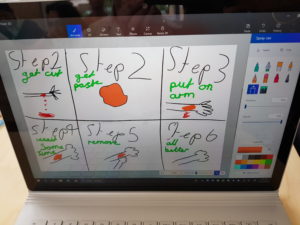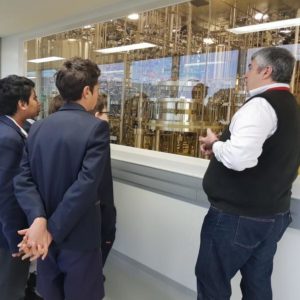Student Superheroes Fighting Superbugs at Whittlesea Tech School
By Dr Catriona Nguyen-Robertson MRSV
Antimicrobial resistance (AMR) threatens the effective treatment of a growing range of infectious diseases. Without effective antimicrobials, the success of modern medicine in treating infections will be drastically reduced. Over one million people die each year due to drug-resistant infections because their diseases are untreatable,1 and this could rise to as many as 10 million by 2050 if AMR is not addressed.2 In response, the World Health Organization (WHO) has declared AMR as one of the top ten global public health threats that we face.3
Whittlesea Tech School calls on superheroes to fight superbugs. In this case, the superheroes are Victorian secondary school students. Students are invited to undertake an investigation: to develop antimicrobial products that kill harmful bacteria while keeping the good ones safe.
Not all bacteria and viruses are out to get us. Each of us houses a thriving ecosystem of microbes, including bacteria, viruses, and fungi, which is referred to as our microbiome. Although they are microscopic, these microbes have a mutually beneficial relationship with us, and contribute immensely to our health. They live on our skin, in our airways, and especially in our gut. In fact, the average human has an estimated 38 trillion bacterial cells, outnumbering their 30 trillion human cells.4 Whittlesea Tech School’s Biotechnology in Focus program teaches students about the relationships we have with microbes – both good and bad.
Our microbiome is one of the first lines of defence against pathogens. By occupying space and taking up nutrients along our barriers, harmful “invaders” (pathogens) have fewer resources with which to grow and hence cause disease. Our microbiome also fine-tunes the immune system: it plays a role in immune system training and development and there is constant cross-talk between the two.5 In addition, Beneficial bacteria also can perform tasks that our own cells cannot, such as metabolising nutrients that we cannot digest (such as fibre) into usable molecules for our cells.
Whittlesea Tech School encourages students to consider the importance of our microbiome, as it can be harmful to wipe out bacteria that keep us healthy. Without good bacteria present, the immune system becomes dysregulated, and disease-causing bacteria are given a chance to flourish. The result can be infections and autoimmune diseases, such as inflammatory bowel disease. Courses of antibiotics affect our gut microbes, which can allow pathogenic bacteria to colonise the gut, and is why probiotics are often recommended following antibiotics. Clostridioides difficile (formerly known as Clostridium difficile) is an example of an opportunistic pathogen that causes disease following antibiotic treatment, and is the leading cause of hospital-acquired infectious diarrhoea.6 It is therefore important when designing new antimicrobial agents to consider only targeting disease-causing microbes – otherwise they could make things worse.
Adding to the AMR crisis is shortage of new antibiotics; pharmaceutical companies do not want to invest in drugs that are complex to develop and might not work several years down the track. Because of this, no new classes of antibiotics have been invented for decades – any new antibiotic is simply a variant of existing compounds discovered prior to 1984. Over the course of a term, students are guided through a design thinking process to create and market a new antimicrobial product.
As students – or any scientists – investigate solutions to the AMR crisis, many turn to nature. Over the years, nature has given us many valuable medicines, including most of the antibiotics we use today. Antibiotics are produced by soil bacteria and fungi, killing off competition when competing with other microbes for food and water and other limited resources. Penicillin, for example, was discovered when Dr Alexander Fleming realised that the mould on his rotting food produced a chemical that killed bacteria. Today, scientists study the incredible diversity of microbes, including bacteria and fungi, hidden within soil to search for the next antibiotic. The search is made easier with the help of citizen scientists around the country as part of the Soils for Science program, who send soil samples from their backyards, gardens, and farms to microbiologists at the University of Queensland, and with school students – like those who visit Whittlesea Tech School – learning to design innovative solutions.

As part of a pilot program in 2020, students at four partner schools rose to the challenge of producing their own antibiotics at Whittlesea Tech School. Students were invited to walk in the shoes of a scientist to create their own bacteria-fighting serums from food- or plant-based extracts. They cultured two different bacteria in the Melbourne Polytechnic laboratories with which they could test their solutions: Lactobacillus acidophilus, usually found in the intestine, and Escherichia coli, which is also common in the gut but there some harmful strains cause diarrhoea. The students’ goal was to design a product that would kill E.coli while leaving L. acidophilus (representative of healthy gut microbes) unharmed. Once students had successfully developed a serum, the next phase of the “design sprint” was to propose a product incorporating their antimicrobial solution (e.g. Band-Aids infused with an antibiotic extract or drinks). More recently, students have participated in the renamed Medical Biotech Scientific Inquiry program remotely, developing a method to test the antimicrobial properties of a chosen plant-based extract (such as olive oil, peppermint, or manuka honey), and producing a scientific poster to outline their findings.
The Biotechnology in Focus Program is not only centred around scientific investigation, but also on building career awareness of the biotechnology industry. “We have Australia’s largest biotech industry on our doorstep,” says Sandra McKechnie, Director of Whittlesea Tech School. Sandra wants to make the most of the Tech School’s location, and to provide a strong link between industry and education.

For the first time, CSL Broadmeadows opened its doors to 100 secondary students as part of the pilot program, for students to tour the laboratories and hear from the heads of the HR, Research, and Manufacturing divisions. “Biotechnology is not an industry that is very well-known within Australia,” says Kathy Sacca, Director of Talent Development at CSL Behring. It has been a great opportunity for students to have their minds opened to real biotechnology applications and jobs here in Melbourne that they were not previously aware of – many students even commented that they are now considering a career in the biotechnology industry.
“I never knew much about biotechnology…and I think it’s amazing. I think it’s the way of the future,” said a student from Viewbank College. Students loved the program and took ownership of their research – continuing to work on their projects over lunch time and at home.
Biotechnologists are going to be required to solve the challenges that society will be facing in the future. “Tech schools are designed to prepare students for jobs of the future,” says Sandra. Whittlesea Tech School is therefore committed to provide opportunities for students to innovate and prototype solutions to real world problems and challenges.
You can learn more about the Biotechnology in Focus program at: whittleseatechschool.vic.edu.au/program/medical-biotech-scientific-inquiry
Watch an overview of the Biotechnology In Focus Pilot Program at Whittlesea Tech School at: youtu.be/6NVeMp9diGw
References:
- Thompson, T. (2022). The staggering death toll of drug-resistant bacteria. Nature. doi.org/10.1038/d41586-022-00228-x.
- Wellcome Trust and UK Government. (2016). Tackling drug-resistant infections globally: Final report and recommendations. The Review on Antimicrobial Resistance. amr-review.org/sites/default/files/160518_Final%20paper_with%20cover.pdf
- World Health Organization. (2021). Antimicrobial Resistance. Fact sheet. who.int/news-room/fact-sheets/detail/antimicrobial-resistance (Accessed 17th May 2023).
- Sender, R., Fuchs, S. & Milo, R. (2016). Revised Estimates for the Number of Human and Bacteria Cells in the Body. Plos Biology. 14(8): e1002533 doi.org/10.1371/journal.pbio.1002533.
- Zheng, D., et al. (2020). Interaction between microbiota and immunity in health and disease. Cell Research, 30. 492-506. doi.org/10.1038/s41422-020-0332-7
- Gursoy, S., et al. (2007). Clostridium difficile infection frequency in patients with nosocomial infections or using antibiotics. Hepatogastroenterology. Sep;54(78):1720-4. PMID: 18019703.






